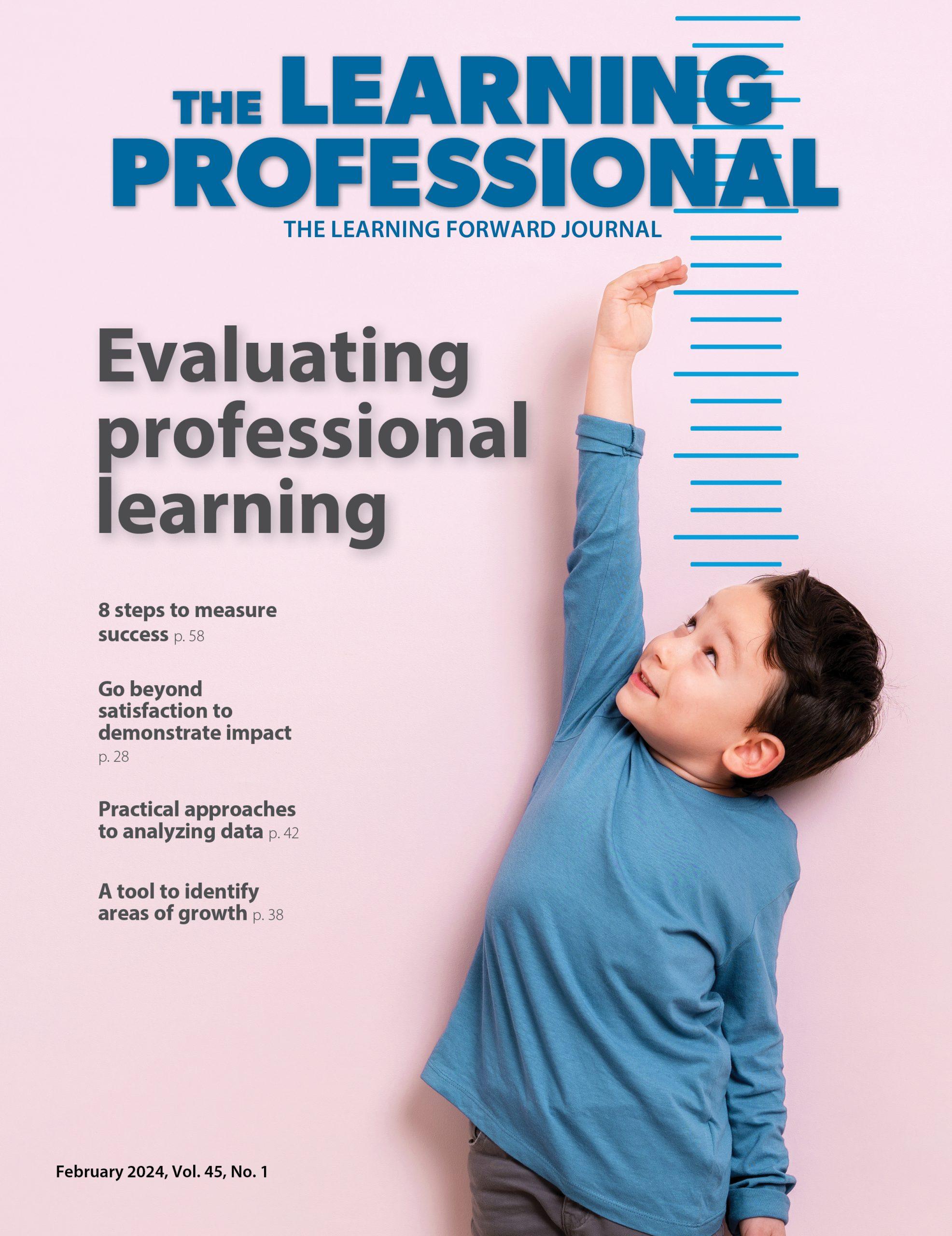No Child Left Behind brought with it a barrage of data from standardized tests. But when do teachers have time to analyze student data? The first days of school are hectic preparing classrooms, organizing supplies, learning the names on class rosters, and completing mounds of paperwork. To give teachers time and support to learn from student data to improve practice, Boone County Schools in West Virginia initiated DDay — a day for data disaggregation before the beginning of each school year.
Read the remaining content with membership access. Join or log in below to continue.
Sed ut perspiciatis unde omnis iste natus error sit voluptatem accusantium doloremque laudantium, totam rem aperiam, eaque ipsa quae ab illo inventore veritatis et quasi architecto beatae vitae dicta sunt explicabo. Nemo enim ipsam voluptatem quia voluptas sit aspernatur aut odit aut fugit, sed quia consequuntur magni dolores eos qui ratione voluptatem sequi nesciunt. Neque porro quisquam est, qui dolorem ipsum quia dolor sit amet, consectetur, adipisci velit, sed quia non numquam eius modi tempora incidunt ut labore et dolore magnam aliquam quaerat voluptatem.
Authors
No Child Left Behind brought with it a barrage of data from standardized tests. But when do teachers have time to analyze student data? The first days of school are hectic preparing classrooms, organizing supplies, learning the names on class rosters, and completing mounds of paperwork. To give teachers time and support to learn from student data to improve practice, Boone County Schools in West Virginia initiated DDay — a day for data disaggregation before the beginning of each school year.
Coming together for a day outside their regular contract, teachers in this small rural school system strategically reviewed test results and developed plans of action for the new school term to address individual and schoolwide strengths and challenges. For three years, student achievement scores have shown steady gains.
For school systems to improve student achievement for all children, the foundation on which NCLB was written, teachers and administrators need time to disaggregate student data (the process of analyzing the data for distinct subgroups of student population) to make instructional decisions and plans. Federal legislation requires schools to disaggregate achievement data on the following variables: major racial and ethnic groups, English language proficiency status, students with disabilities as compared to all other students, and economically disadvantaged students as compared to all other students (U.S. Department of Education, 2004).
COUNTYWIDE SUPPORT FOR D-DAY
D-Day is scheduled for five days in August in various locations across the county. Teachers are notified of their school’s D-Day before the end of the school year to allow them to schedule vacation and other plans around their assigned day. Schools are grouped by similar grade levels and student populations so that staffs from similar school zones or feeder areas can work together and compare school practices and initiatives. All central office county improvement team members, including the superintendent, attend all five D-Day sessions to demonstrate the importance of data disaggregation and instructional planning.
D-Day costs the school system an average day’s wage for each professional attending the work session (approximately $75,000). With 50% of the district’s student population in the low socioeconomic status subgroup (students receiving free or reduced lunch) and 24% also in the students with disabilities category for accountability, the benefits in student achievement and planning for instruction far outweigh the expense.
Participation in D-Day is optional. Fifty-five percent of school-level teachers and administrators attended the first year. By the third year, attendance rose to 70%. The opportunity to analyze student test results collaboratively and to identify strengths and challenges is compelling. We engage in conversations about how the purpose of reviewing data is to gain insight into how to help students achieve their full potential. We discuss both legal (NCLB) and moral reasons for changing our beliefs and classroom practices. We ask two questions of all D-Day participants: Do you believe that you control the conditions that will result in student success? And do you believe that given the time and conditions, all children, regardless of race, disability, gender, or socioeconomic status, will learn essential skills?
The district believes that “disaggregation is not a problem-solving strategy, but a problem-finding strategy” (Lezotte, 2001, p. 85). This belief is reflected in the Boone County school improvement plan, in which all curriculum/instructional decisions are based on sound research and practices. Before the first D-Day took place, administrators and teachers from across the county studied books and articles to learn about best practices and research that influence student achievement. Staff members studied Assembly Required: A Continuous School Improvement System (Effective Schools Products, 2001), Classroom Instruction ThatWorks (ASCD, 2001), and Closing the Achievement Gap: No Excuses (APQC, 2002). Principals and administrative leaders attended several state and national conferences to gain a greater understanding of the importance of analyzing student data.
During the winter before the first D-Day, Patricia Davenport was a guest speaker in our school district. She described her former school district’s (Brazosport, Texas) eight-step process for closing the achievement gap to all professional staff members. The steps include:
- Data disaggregation
- Timeline development
- Instructional focus
- Assessment
- Tutorials
- Enrichment
- Maintenance
- Monitoring
By studying these education leaders together, the district established a common vocabulary and level of knowledge to ready all staff to carefully use student data.
ALL IN A DAY’S WORK Each
D-Day begins with a continental breakfast and a welcome from the superintendent. School personnelare seated by either department or grade levels and have all the materials they need for the day’s work. School leaders share the district’s fundamental beliefs about data, then the educators get to work.
Together, the large group looks at countywide test results. Then teachers receive copies of most recent student test scores and worksheets for recording their findings. Smaller groups analyze data through a strategy called “stoplight highlighting.” (See chart on p. 36.)
Stoplight highlighting is an effective visual to evaluate strengths and weaknesses. Teachers compare their green, yellow, and red highlights with their colleagues. These conversations are the most useful part of the day.
Teachers from different schools compare test scores and quiz one another on how they taught various concepts. For example, at one session, Diane Bolyard, an 8th-grade math teacher at Madison Middle School, celebrated with a fellow math teacher. “Last year, I had more yellow and red under the fractions standard. This year, I have more green,” she said.
After lunch, teachers complete two more tasks using stoplight highlighting results. They record their strengths, concerns, and challenges, and meet in their school groups for reflection. They share commonalities and plan focus calendars for the first few months of school. Through their alignment of instruction to the state content standards and objectives and choosing effective instructional strategies, teachers are empowered to make a difference in classroom instruction. The emphasis on Bloom’s Taxonomy throughout the district has allowed teachers to focus on higher-order thinking skills and pulled them away from the lowerlevel (recall, define, identify) style of questions found on standardized tests. After working through D-Day, each participant leaves with a folder of disaggregated data and a framework for teaching in the coming school term.
POSITIVE OUTCOMES
As a result of D-Day, not only are test scores rising in Boone County (see chart at right), but teacher morale is as well. While teachers were at first affected negatively by the strict legislative mandates and policy structure of NCLB, they are encouraged to see students mastering content and gradelevel standards. They have had time to analyze test results and make instructional plans before the first bus rolls down Route 119 to pick up students for the new school term.
After the second year of D-Day, teachers were prepared to analyze other sets of data besides the end-of year summative assessment. The local school district began administering benchmarks twice a year so that teachers could see a snapshot of student performance. The county administration scores the benchmarks and returns them to the classroom teacher within 48 hours. This quick turnaround allows teachers to analyze this new set of data and to make curricular decisions to best meet student needs.
In addition, students are taking ownership in their assessment results. Each year, school personnel hold conferences with individual students to review test results using the stoplight highlighting strategy. Students highlight their strengths and weaknesses and are asked to set goals for the new school term.
Many schools have instituted goal notebooks and refer to them throughout the year so that students can assess personal progress. At Ramage Elementary School in Danville, a pre- K through grade 5 school with 275 students, students keep electronic student portfolios. Their personal and academic goals are kept on file, and students monitor their yearly progress with charts and graphs. The 5th-grade teachers wrote a grant and all students carry their electronic portfolios on flash drives purchased with grant monies.
Participants agree on the value of D-Day for improving teaching and learning. Brenda Viars, principal of Sherman Elementary in Comfort, a consolidated elementary school with 550 students in grades pre-K through 6, asked the board of education to allow central office staff to continue offering D-Days before the beginning of each school year. Although an extra expense to the school system, “it is an invaluable day of planning, staff development, and data disaggregation,” she said. The time has never been given to teachers in the past for them to analyze student test data. “It makes the start of school so much more productive and allows us to align our school goals to student achievement,” Viars said.
Barbara Deal, NCLB Title I teacher at Sherman Elementary, told the board that “D-Day sets the tone for the entire school year. Staff and administration know from day one what needs to be accomplished to improve student achievement.” Her colleague, Lisa Lowe, said, “I can’t envision beginning the school year without the information I receive on D-Day. It maps the curriculum for the entire school year.” Sherman Elementary has moved from a school listed as failing to make Adequate Yearly Progress (AYP) to being named a West Virginia School of Excellence for 2006. The results are in: Finding time to share test data with teachers and administrators before the beginning of the new school term has become a route to victory for Boone County Schools.







